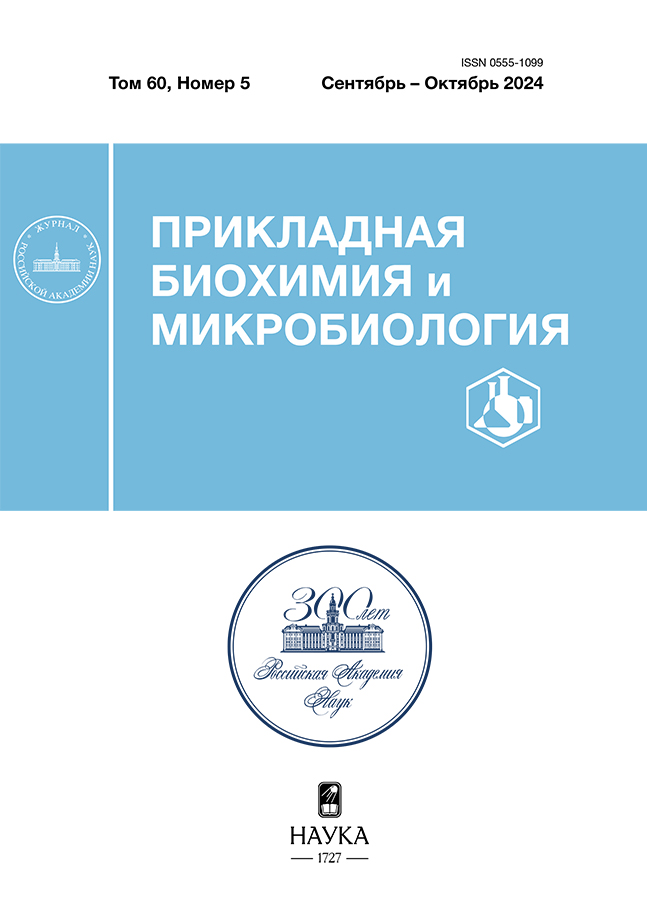Development of a bio-selecting agent based on immobilized bacterial cells with amidase activity for bio-detection of acrylamide
- Autores: Protasova E.M.1, Maksimova Y.G.1,2
-
Afiliações:
- Perm Federal Research Center, Ural Branch, Russian Academy of Sciences
- Perm State National Research University
- Edição: Volume 60, Nº 5 (2024)
- Páginas: 536-544
- Seção: Articles
- URL: https://medjrf.com/0555-1099/article/view/681861
- DOI: https://doi.org/10.31857/S0555109924050115
- EDN: https://elibrary.ru/QSURJQ
- ID: 681861
Citar
Texto integral
Resumo
Actinobacteria cells Rhodococcus erythropolis 4-1 and Rhodococcus erythropolis 11-2 and Proteobacteria Alcaligenes faecalis 2, which have amidase activity, were immobilized by entrapping barium alginate and agarose into the gel structure, as well as by obtaining biofilms on thermally expanded graphite (TEG). The operational stability of such immobilized biocatalysts after storage in frozen and dehydrated form was determined, and a prototype of a conductometric acrylamide biosensor based on such a bioselective agent was developed. The most preferred method for storing immobilized cells was freezing at temperatures from –20 to –80°C; long-term storage is also possible wet at 4–25°C. It was shown that these cells were most preferable for the biodetection of acrylamide A. faecalis 2, immobilized in an agarose gel structure. An agarose gel with bacterial cells immobilized in its structure had greater mechanical strength and stability during successive cycles of conversion of acrylamide into acrylic acid compared to barium alginate gel. The mechanical strength of barium alginate gel can be enhanced by the addition of carbon nanomaterials during cell immobilization. Growing biofilms on carbon materials used for manufacturing electrodes is also promising. Biofilms of R. erythropolis 11-2 on TEG are capable of converting acrylamide into acrylic acid in more than 20 reaction cycles while maintaining at least 50% amidase activity.
Palavras-chave
Texto integral
Sobre autores
E. Protasova
Perm Federal Research Center, Ural Branch, Russian Academy of Sciences
Email: yul_max@mail.ru
Institute of Ecology and Genetics of Microorganisms, Ural Branch, Russian Academy of Sciences
Rússia, Perm, 614081Yu. Maksimova
Perm Federal Research Center, Ural Branch, Russian Academy of Sciences; Perm State National Research University
Autor responsável pela correspondência
Email: yul_max@mail.ru
Institute of Ecology and Genetics of Microorganisms, Ural Branch, Russian Academy of Sciences
Rússia, Perm, 614081; Perm, 614990Bibliografia
- Bedade D.K., Dev M.J., Singhal R.S. // Biochem. Eng. 2019. V. 149. 107245. https://doi.org/10.1016/j.bej.2019.107245
- Duda-Chodak A., Wajda Ł., Tarko T., Sroka P., Satora P. // Food Funct. 2016. V. 7. № 3. P. 1282–1295. https://doi.org/10.1039/c5fo01294e
- Kusnin N., Syed M.A., Ahmad S.A. // JOBIMB. 2015. V. 3. № 2. P. 6–12. https://doi.org/10.54987/jobimb.v3i2.273
- Лопушанская Е.М., Максакова И.Б., Крылов А.И. // Вода: Химия и Экология. 2017. № 10. С. 3–10.
- Hu Q., Xu X., Fu Y., Li Y. // Food Control. 2015. V. 56. P. 135–146. https://doi.org/10.1016/j.foodcont.2015.03.021
- Куликовский А.В., Вострикова Н.Л., Кузнецова О.А., Семенова А.А., Иванкин А.Н. // Аналитика и контроль. 2019. Т. 23. № 3. С. 393–400. https://doi.org/10.15826/analitika.2019.23.3.002
- Liu C., Luo F., Chen D., Qiu B., Tang X., Ke H., Chen X. // Talanta. 2014. V. 123. P. 95–100. https://doi.org/10.1016/j.talanta.2014.01.019.
- lgnatov O.V., Rogatcheva S.M., Kozulin S.V., Khorkina N.A. // Biosensors & Bioelertronics. 1997. V. 12. № 2. P. 105–111.
- Batra B., Lata S., Sharma M., Pundir C.S. // Anal. Biochem. 2013. V. 433. P. 210–217. https://doi.org/10.1016/j.ab.2012.10.026
- Krajewska A., Radecki J., Radecka H. // Sensors. 2008. V. 8. P. 5832–5844. https://doi.org/10.3390/s8095832
- Li D., Xu Y., Zhang L., Tong H. // Int. J. Electrochem. Sci. 2014. V. 9. P. 7217–7227. https://doi.org/10.1016/S1452-3981(23)10961-8
- Huang S., Lu S., Huang C., Sheng J., Zhang L., Su W., Xiao Q // Sensors and Actuators B. 2016. V. 224. P. 22–30. https://doi.org/10.1016/j.snb.2015.10.008
- Silva N., Gil D., Karmali A., Matos M. // Biocat. Biotrans. 2009. V. 27. № 2. P. 143–151. https://doi.org/10.1080/10242420802604964
- Silva N.A.F., Matos M.J., Karmali A., Rocha M.M. // Port. Electrochim. Acta. 2011. V. 29. № 5. P. 361–373. https://doi.org/10.4152/pea.201105361
- Решетилов А.Н., Плеханова Ю.В. Биосенсорные системы и топливные элементы на основе микробных клеток. В кн. Иммобилизованные клетки: биокатализаторы и процессы. / Ред. Е.Н. Ефременко. М.: РИОР, 2018. 499 с.
- Плеханова Ю.В., Решетилов А.Н. // Журнал аналитической химии. 2019. Т. 74. № 12. С. 883–901. https://doi.org/10.1134/S0044450219120090
- Michelini E., Roda A. // Anal. Bioanal. Chem. 2012. V. 402. P. 1785–1797. https://doi.org/10.1007/s00216-011-5364-x
- Решетилов А.Н. // Прикл. биохимия микробиология. 2015. Т. 51. № 2. С. 268–274. https://doi.org/10.7868/S055510991502018X
- Sharma M., Sharma N.N., Bhalla T.C. // Rev. Environ. Sci. Biotechnol. 2009. V. 8. P. 343–366. https://doi.org/10.1007/s11157-009-9175-x
- Максимова Ю.Г., Горбунова А.Н., Зорина А.С., Максимов А.Ю., Овечкина Г.В., Демаков В.А. // Прикл. биохимия микробиология. 2015. Т. 51. № 1. С. 53–58. https://doi.org/10.7868/S055510991406010519
- Демаков В.А., Васильев Д.М., Максимова Ю.Г., Павлова Ю.А., Овечкина Г.В., Максимов А.Ю. // Микробиология. 2015. Т. 84. № 3. С. 369–378. https://doi.org/10.7868/S0026365615030039
- Мочалова Е.М., Максимова Ю.Г. // Вестник Пермского университета. Серия биология. 2020. № 1. С. 26–32. https://doi.org/10.17072/1994-9952-2020-1-26-32
- Максимова Ю.Г., Якимова М.С., Максимов А.Ю. // Катализ в промышленности. 2019. Т. 19. № 1. С. 73–79. https://doi.org/10.18412/1816-0387-2019-1-73-79
- Китова А.Е., Колесов В.В., Решетилов А.Н. // Известия ТулГУ. Естественные науки. 2018. № 1. С. 9–16.
- Максимова Ю.Г., Васильев Д.М., Зорина А.С., Овечкина Г.В., Максимов А.Ю. // Прикл. биохимия микробиология. 2018. Т. 54, № 2. С. 158–164. https://doi.org/10.7868/S0555109918020058
- Понаморева O.H., Арляпов В.А., Алфёров В.А., Решетилов А.Н. // Прикл. биохимия микробиология. 2011. Т. 47. № 1. С. 5–15.
- Перчиков Р.Н., Арляпов В.А. // Известия ТулГУ. Естественные науки. 2023. № 1. С. 69–81. https://doi.org/10.24412/2071-6176-2023-1-69-81
Arquivos suplementares















